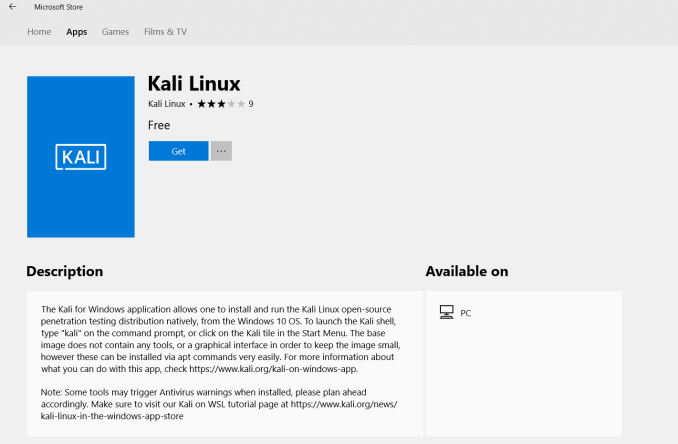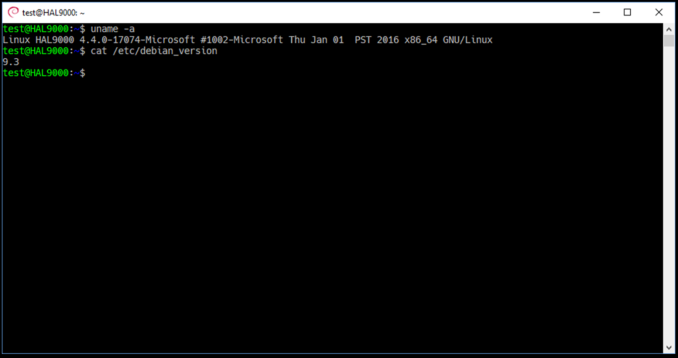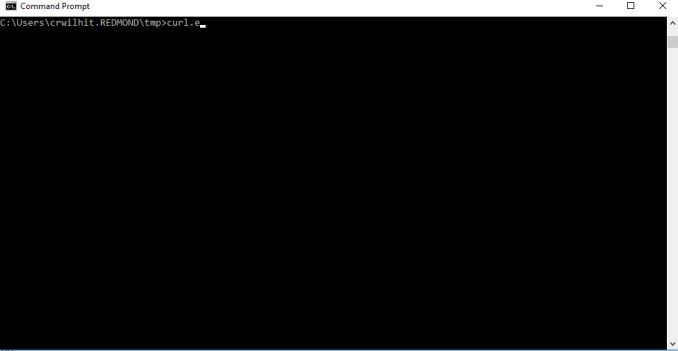The Windows 10 April Update (1803): The Littlest Big Update
by Brett Howse on May 25, 2018 8:00 AM EST- Posted in
- Software
- Operating Systems
- Windows
- Microsoft
- Windows 10
Command Line and Windows Subsystem for Linux
The Windows Subsystem for Linux (WSL) has dramatically changed the development opportunities on Windows, and has become very popular. Microsoft has updated it continuously as well, bringing requested features and updates to really improve the experience. With the April Update, there’s once again some nice additions to Linux support on Windows.
What was once a somewhat arduous task, installing Linux distros on Windows now is something that’s moved to the Store, and for the April Update, there’s a couple of new distros available. Kali Linux is now an option, as well as the very popular Debian GNU/Linux. For those that want to run multiple distros, Windows 10 supports having multiple versions installed and running simultaneously.
Likely a very vocal request, background tasks were previously available but would end if the console window was closed. With the April Update, that’s no longer the case.
The WSL team has now brought Unix sockets to Windows as well, so you can communicate over these sockets between Windows and WSL.
People that do Linux admin will be aware of OpenSSH, and Microsoft has brought both a the OpenSSH client and server to Windows. The client is enabled by default, and the server is an on-demand feature as it likely should be.
Both Tar and Curl commands have also arrived in Windows 10’s command line interface, and Microsoft has created a new tool called wslpath to let you easily convert paths between Windows and Linux.
You can now do Linux permissions on files, with the new permission added as metadata to the file, and case sensitivity is now an opt-in feature, although to start an argument, case sensitivity is one of the most annoying features of Linux.
Console Applications Now Supported as UWP
There’s often no easier solution to a problem than a quick console application, but before the April Update, there was no way to distribute these apps through the Store. With the April Update, Console UWP is now supported, so developers can ship and update through the store just like any other UWP app.














161 Comments
View All Comments
nico_mach - Friday, May 25, 2018 - link
They pretty much did? These are the best, most useful implementations of Linux on Windows I've seen, and they're only lacking server versions.If you mean, why don't they ship linux? Well, they kind of do on Azure. There's no real reason to do so as a consumer facing OS, unless you're suggesting Windows EdgeOS? Which is very clearly crossing the line into why-bother territory.
PeachNCream - Tuesday, May 29, 2018 - link
There's no value in running something other than a *nix kernel at this point. If they want to keep costs low in the OS development department, then its probably as good a time as any to make the transition. The open source community and Microsoft could further mutually benefit from working together as would software compatibility and cross-platform functionality. All of that can be relatively hidden from the end user by the OS UI so aside from the one-time cost of conversion, a cost they could absorb into pushing out Windows 11 -- something that they'll eventually have to do anyway given predominant market forces, I think staying on their current course is a misstep and a missed opportunity for the computing industry in general and Microsoft in specific.ChristopherFortineux - Friday, June 8, 2018 - link
Because linux will never be fully supported for everyday use and software across the board. They can run the kernel within Windows already.Kvaern1 - Friday, May 25, 2018 - link
"But, once it does start rolling out through Windows Update, there will be some new things to check out, so let’s take a look at some of them."Not sure what you mean here. My home PC got it through Windows Update on April 30th.
Brett Howse - Friday, May 25, 2018 - link
You had to manually check for updates for that to happen on the 30th. The auto rollout has been a lot less aggressive.ikjadoon - Friday, May 25, 2018 - link
The flip side is that I was checking for *other* updates (some minor security fixes), not 1803.Got my first blue screen ever in Windows 10 immediately after the update. Plus a host of other minor bugs (Chrome freezing, OEM partition assigned a drive letter, etc.).
I would’ve appreciated either the choice to install 1803 (but why can’t I take minor updates like everyone else?) or don’t allow it all thru the OS unless you use the Media Creation Tool.
I didn’t need to be a beta tester seemingly a month early.
Drazick - Friday, May 25, 2018 - link
I wish they gave us back the option to customize Windows on installation phase.I'd really want to install a minimal Windows.
I don't need all this bloatware. I want my system to be compact and efficient.
LazloPanaflex - Friday, May 25, 2018 - link
You want "minimal windows"? Then do yourself a favor and upgrade to Win 7.Here's my recent experience with 10 -- bought the in-laws a lower end Dell laptop with 10 pre-installed. Could not get their slightly older HP printer working, even with win 10 drivers from HP's website. Bought a Canon printer, same problem. Logitec speakers would not work correctly for some reason. And the coup de grace? Windows updates refused to download. So I put Win 7 on it, and it's running great.
Microsoft can shove 10 up their collective asses.
Drazick - Friday, May 25, 2018 - link
Actually Windows 10 has smaller footprint than Windows 7 and it is more efficient.But still there are som many applications and background processes I don't want / need.
I wish I could not have them at all.
BurntMyBacon - Tuesday, May 29, 2018 - link
As far as space goes, I agree. Also faster boot time. More efficient in general operation is not so clear. As you said, so many applications and background processes.